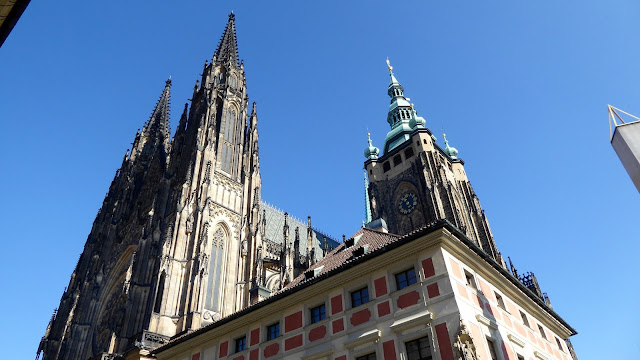We arrived in Prague from Copenhagen in the morning and after checking into the hotel, immediately set out to find some lunch. The Vltava River runs through the city.
Most of the city caters to tourists, touting Czech food and Pilsner beer.
The cobblestone streets and old buildings are charming.
These women are hawking some tourist attraction.
There are numerous narrow passageways.
The John Lennon wall was painted after his assassination in 1980. It has been painted over many times and you can typically find a busker doing his best John Lennon impression.
This canal in the Kampa area features lovers' locks and a water wheel.
Prague has numerous ways for tourists to see the city, including by classic car.
On the hillside you can see the track for the funicular, which we used in 2002 to get up to our lackluster accommodations: student dormitories. We were happy to be in a hotel this time.
After a week in Copenhagen, Brian is shocked to see the prices - a half liter of beer is only $1.50!
One of Prague's many churches.
Prague largely escaped destruction during World War II, so much of the city's older architecture is preserved.
The crowds leading to the Charles Bridge. We decided to go another way to get across the river.
The German embassy.
Despite several wrong turns, we found this bar tucked away along a windy street.
Decoration at the entrance to the film museum.
Looking up towards Prague Castle.

A modern train station contrasts with the brutalist buildings.

Ancient ticket machines! They only took coins.

The view toward the Czech Senate building complex, Wallenstein Palace.
The gardens include artificial rock wall.


We were thrilled for our first sunny day of the trip.

We braved the Charles Bridge on this day.
The bridge offers great views of the river.
On the other side of the river, the Old Town Square is the central tourist attraction. All the streets leading there are filled with shops and restaurants.

Looking back across the river to the Prague Castle.

The National Theatre and the New Stage.


We did a (self-guided) walking tour of the sites of the Velvet Revolution. This marks the spot where police repressed student protesters on November 17, 1989.

This is an interesting sculpture, Franz Kafka's head by Prague sculptor David Cerny (not part of the tour).
The Palace Adria is where Vaclav Havel and other activists formed the Civic Forum and met to discuss strategy.

More interesting Prague architecture.
These are Czech pastries called "turtlenecks."

Architecture.
This is Wenceslas Square where 500,000 protesters gathered November 1989.
Vaclav Havel spoke from the balcony here. Of course, it's now a department store!

This reminds me of Grand Budapest Hotel. I love the architecture!

The statue of Saint Wenceslas that protesters decorated with propaganda during the protests and still are!
This astronomical clock is quite the tourist attraction. Every hour, an intricate dance occurs as 12 apostles emerge from the clock and rotate around the column. The clock was built in 1410!
The Old Town Square!
On our last day, we toured Prague Castle.

The castle offers sweeping views of the city.
We then walked along the river.
These are statues by David Cerny. There are many interpretations of their meaning. I won't speculate here.
The river has a channel for boats to pass through, complete with locks.
Across the river, you can see the Dancing Building, built by Frank Gehry.
We then made it to Vysehrad Cemetery to see Karel Capek who popularized the term "robot."

On our last night we visited a great cocktail bar, although this bar may have been more appropriate:
Maybe next time!























































































